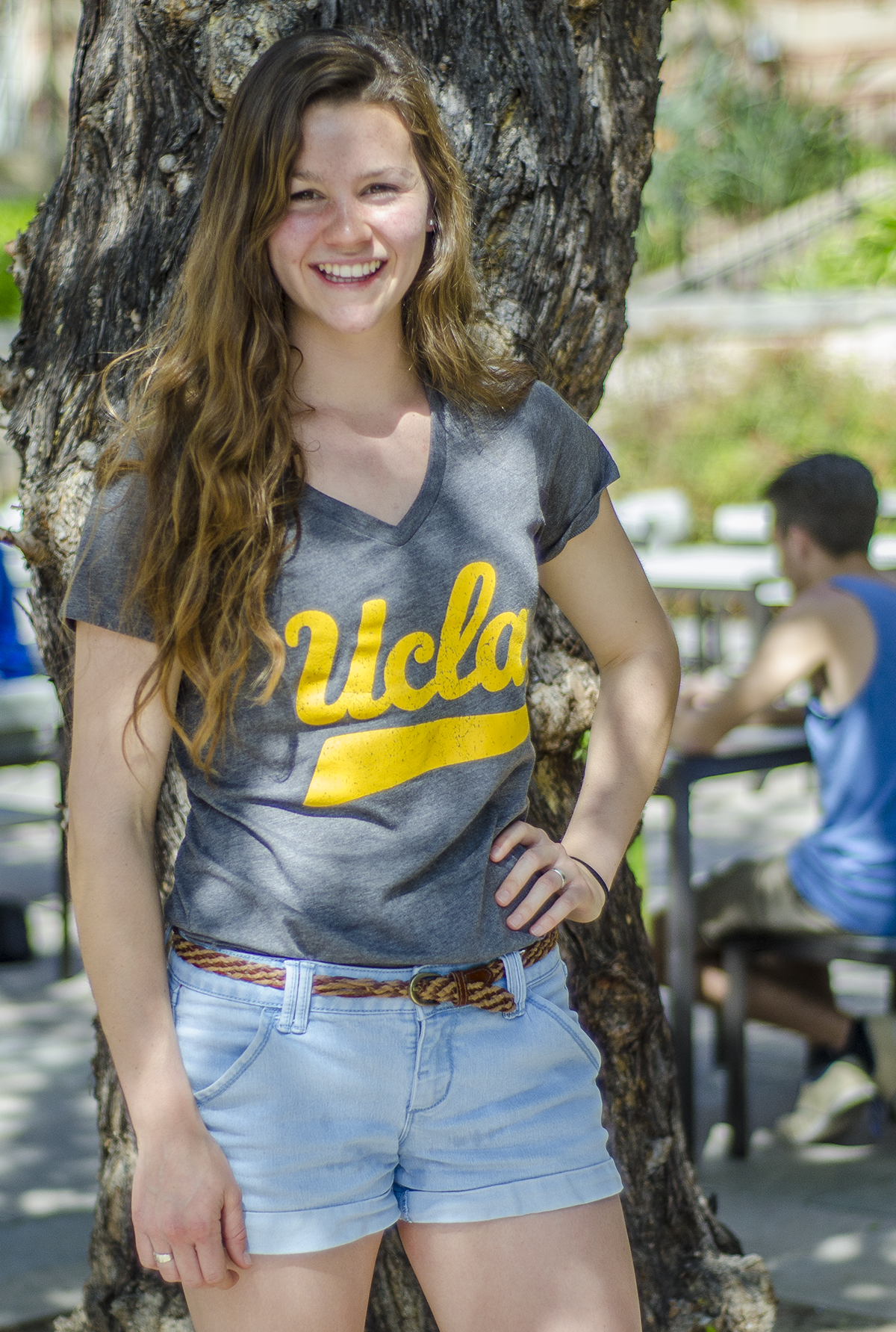Student Sartorialist: UCLA BearWear hinders individual style, expression

First-year biochemistry student Chloe Purgason sports her BearWear apparel with a classic UCLA T-shirt that is often seen around campus. This week, A&E columnist Noor Gill explores the effects of BearWear on UCLA’s style.
(Agnijita Kumar/Daily Bruin senior staff)
By Noor Gill
April 10, 2014 12:00 a.m.
One hood, two drawstrings and four letters – the UCLA sweatshirt, a clothing item that is probably present within more closets of our student body than any other.
Along with the sweatshirt, T-shirts, baseball hats, sweatpants and even spirit wear such as fuzzhead wigs are clothing items included in the possible options of UCLA BearWear.
The frequency of which our students wear these items makes it almost impossible for anyone visiting our campus to forget exactly where they are.
The launch of BearWear in the 1980s, coupled with the UCLA campus serving as a part of the 1984 Olympic Village, resulted not only in defining our school’s brand, but also in the promotion of our apparel to a wide-reaching international market. UCLA later became the first school to authorize the use of its trademark to other companies.
Thirty years later, UCLA apparel is now sold in stores spanning the globe and makes over $600,000 in yearly royalties, ranking No. 32 on a list of top-selling universities in merchandise for 2012-2013.
Although expressing school pride and making money through merchandising are considered to be positive things, a less-than-positive question comes to mind when I see UCLA sweatshirt after UCLA sweatshirt walk by me on campus: How willing are we as students to forsake our individuality in favor of looking like carbon copy clones?
And what does this tendency of preferring to look the same say about our sense of fashion expression?
With BearWear being the go-to clothing for students to throw on before rushing out the door, to what degree does its accessibility stifle the possible creativity that can go into styling an outfit that represents individuality rather than conformity?
While the lack of individual expression that coincides with wearing collegiate clothing will always exist for me, I do not generalize all clothing with the UCLA logo embroidered on it as unattractive. There have been many recent efforts to make these basics fashionable.
With UCLA licensing its brand to more fashion-centric companies, such as UCLA Clothing International, the traditional collegiate wear we are accustomed to is expanding beyond simply representing an institution of education and is now representing a desirable Southern Californian college lifestyle as well.
Student magazines and organizations such as UCLA Fashion and Student Trends have also made the push toward changing the way that college wear can be styled.
Third-year psychology student and model in a UCLA Fashion and Student Trends photo shoot, Princess Addison, said that although she doesn’t usually wear school-related wear, she was surprised by how different the designs looked and the twist that they brought to UCLA style.
Although the efforts made by UCLA-affiliated companies and clubs toward expansion beyond sad, gray sweatsuits is admirable, it is still hard for some to accept the omnipresent nature of college wear on campus as a positive trend in terms of fashion expression.
“Maybe students’ style is to represent their university and show their school spirit,” Addison said. “But perhaps if BearWear wasn’t as popular, more people wouldn’t rely on it so much and would be more compelled to wear things that showed their personality a bit more.”
Going past the issues of aesthetics and frequency, the reason I can never fully get behind collegiate clothing is that I can’t help but think that the popularity of UCLA wear is suppressing a value that the school claims to hold highly, which is diversity – a diversity not only in its types of students and learning opportunities, but also in expression.
Almost every student owns UCLA clothing, and I am not arguing that wanting to show school pride through clothing is inherently negative, but rather than overseas companies or the clothes on Ackerman Union’s racks defining our school’s sense of style, I would prefer students to write, or rather wear, their own definition of what UCLA fashion should be.


